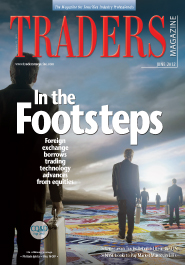
With the majority of equities being traded with algorithms, the handling of small-capitalization stocks has been one of the last vestiges of old-school trading. For small-cap stocks, the buyside will actually pick up the phone, call up sales traders and ask them to use their capital or know-how to move some shares. But those days are fading. Algos are now conquering smaller stocks as well.
That’s remarkable considering that not long ago, the conventional wisdom was that traders would never want to use algos for small-cap stocks. Today, more than half of all small-cap trades use algos, more than double the number five years ago, according to experts. Goldman Sachs and UBS have recently unveiled new algos specifically designed for small-cap names. And small-cap algo use is expected to continue to rise.
Brokers today do not have the appetite for capital commitment that they used to, and the Volcker rule could further curb their ability to commit capital. Plus, both the buyside and sellside have pared back their trading desks, which means fewer people are around with the expertise necessary to handle small-cap names. As if that weren’t enough, fragmentation means there are more venues traders have to search to find the limited liquidity in smaller issues.
All of these things have pushed the buyside to use algos when trading small caps. And with the growth of new small-cap algos, a final holdout of old-guard trading is balancing on the brink.

Jose Marques, global head of electronic equity trading at Deutsche Bank, said his firm’s algos are now trading “easily double” what they used to for small caps. And Enrico Cacciatore, a senior trader at ING Investment Management, said his firm currently does “at least” 50 percent of its small-cap trades with algos, and that number could eventually climb to 75 percent, 80 percent or even higher.
Before the crisis of 2008, brokers had few takers on the buyside for small-cap algos. The importance of that crisis is often overlooked when it comes to the growth of algos, said Jeff Bacidore, managing director and head of algorithmic trading at ITG.
“Capital wasn’t as available as in the past, and people were forced to do things that they may not have otherwise done,” Bacidore said.
In 2008, a few algos were available for trading illiquid stocks, but they had not been frequently used, especially in high-stress situations. The crisis provided an incentive to use algos for small caps, and it offered a unique testing ground to see how they worked during extraordinary events.
The traders found that their algos could handle smaller stocks in a reasonable way. Not everything worked perfectly, but algos proved they were a viable option even for illiquid names.
“The buyside stepped up at that point and said, ‘You guys really need to focus on improving these algorithms,'” said Bacidore. “Some of the tools in their basic form were already out there, but it wasn’t until people really started using them post-Lehman that the industry was forced to make them industrial-strength.”
Commission Staple
Small-cap stocks are defined as having market capitalizations of between $300 million and $2 billion. According to data provided by Zacks Investment Research, there are 1,500 publicly traded small caps out of a total of about 4,500 names. There are another 2,000 micro caps, firms capitalized at less than $300 million.
Despite their numbers, small-cap stocks represent only about 5 percent of the total capitalization and 17 percent of the average daily volume of all exchange-traded securities, excluding ETFs. On average, they trade about 600,000 shares per day, according to Zacks.
Still, small caps make up a large part of commissions. According to a survey by Greenwich Associates last year, about 40 percent of brokerage commissions paid by U.S. institutions are tied to trades on small- and mid-cap stocks.
Prior to 2008, at most 20 percent of small caps were traded using algos. Today, that number has more than doubled, to around 50 percent. Overall, 60 to 70 percent of all trades are done using algos.

In the interest of a larger relationship, brokers providing capital before the crisis would break even or sometimes actually lose money on certain transactions to keep clients happy. Major financial institutions have recovered significantly since the ’08 crisis, but they are less willing to provide the kind of capital they used to, and in the current regulatory environment, they might not be allowed to do so anyway.
The pullback in capital commitment was not the only part of the crisis that helped spur the adoption of algos for small caps. The turmoil of 2008 also led to changes in personnel.
In the aftermath of the crash, the buyside had to cut back the number of traders on its desks. With fewer buyside traders, there were fewer people who knew how to trade illiquid names.
As buyside desks take more control of their trading activity, they are being asked to do more with less, said Peter Sheridan, head of algorithmic distribution for the Americas at Goldman Sachs. The buyside is looking to automation to help them with capacity, while leaving the trader to focus on the more difficult transactions.
Todd Lopez, head of sales for equities electronic trading in the Americas at Goldman Sachs, said his firm designed its new small-cap algorithm so it would not be constrained by some of the traditional measures of volume and time.
Lopez said the algorithm has a great deal of discretion to take advantage of sudden opportunities in liquidity it might find.
“Simply going along with volume in a small-cap name has the potential to create a lot of impact,” he said. “We try to minimize how often the algorithm is forced to trade, especially when conditions are unfavorable.”
High-Touch Comeback?
As the buyside cut back staff on the trading desk, the sellside did the same. Stephen Roney, head of small-cap execution and block trading at UBS, said when the crisis occurred, many brokers retrenched their small-cap businesses and collapsed small-cap trading teams back into their large-cap pods. When the buyside was not getting the same attention from high-touch desks they were getting from a separate small-cap trading team, they had to question the benefits of a high-touch approach.
More recently, high-touch trading has made a bit of a comeback due to declining volumes overall. Roney said the use of algos for small-cap trading spiked a couple years ago and then dropped a bit when overall liquidity declined. He thinks traders will go back to algos for small-cap stocks if the promising return in volume continues, which would make the algos more effective.
“From the very end of last year to the first quarter of this year, we’re seeing a pickup in volumes, specifically in small caps,” Roney said. “As more liquidity returns to small-cap names, I think people will feel a little bit more comfortable with algorithms.”

The latest small-cap-focused algo to be rolled out is UBS’s new offering, Swoop. Launched at the end of February, Swoop aims to capture unanticipated bursts of liquidity in low-volume securities. Roney said it is a testament to the algo’s effectiveness that his team is using Swoop for the firm’s own small-cap trades.
“With the right parameters upon it, it’s very stealthy, it’s very patient, and when it does encounter liquidity, it really takes advantage of it,” he said.
Though better algos are now available, Roney isn’t sure traders will go back to them completely, but adds that regulatory issues could force them to do so. Even though the crisis is history, the Volcker rule’s proposed ban on proprietary trading by banks could curtail capital commitment, and leave clients with no choice but algos.
Even when the buyside works with a broker’s high-touch desk, that desk still could be using algos to help them trade. That’s just a fact of life in today’s fragmented markets. The crisis didn’t cause fragmentation, but the number of new venues continued to grow after 2008.
Dan Nachtman, a principal in global execution services at Bank of America Merrill Lynch, said fragmentation has been another factor in driving small caps into the world of algorithmic trading.
“It was challenging to get a block done-you needed to be in so many places to locate liquidity,” Nachtman said. “Getting that liquidity any other way except electronically just got increasingly difficult.”
With all the sources of liquidity today and the frequency of price movements, if you’re not using an algo, you’re shortchanging yourself, he added.
Though the financial crisis provided an impetus for the growth in algos for small caps, it has been an evolutionary process. Credit Suisse introduced a small-cap algo strategy in 2004, and while the firm has improved its offering over time, the basic premise behind the strategy remains the same.
According to Pankil Patel, head of AES trading for the Americas at Credit Suisse, the idea was to minimize signaling risk, even if it meant not getting any trades done right away.
“It was the first strategy that was not schedule- or participation-based,” Patel said. “It was more opportunistic in nature and the first strategy to integrate off-exchange dark liquidity venues. You could put an order in, and have confidence that the strategy would only trade if the liquidity materialized.”
Patel said that when trading small-cap stocks, algos need to be concerned about what venues they use and understand what order types tend to be available in those venues. For many small-cap names, at least 50 percent of trading takes place in the dark.
If an order is hidden in a dark pool, but then part of it prints to the tape, a short-term trader can get wind of a large institutional order in the process of being executed. Patel said the solution isn’t to simply trade in one venue or another, but to manage the entire trading ecosystem to prevent information slippage.
Hybrid Approach
One way to do that is to merge high-touch approaches with algos in order to create hybrid solutions. Credit Suisse offers this middle ground by customizing algorithms for its clients. The firm tries to incorporate users’ styles, benchmarks and alpha horizons into algos. Patel said the company has done hundreds of customizations over the last six years.
Customization is important at other firms as well. Jefferies & Co., for instance, will look not just at capitalization size, but at individual characteristics of different stocks. The firm tries to understand the behavior of certain names to help clients reach their trading targets.
“The latest generation of algos spend more time on stock-specific characteristics, and not as much trying to define them as a schedule or in some type of bucket, like cap size,” said John Bajus, head of global electronic trading services at Jefferies.
While five years ago the perception was that the majority of small-cap liquidity existed upstairs, much of it is now available in dark pools, and it can be easier to access that dark liquidity by using an algo.
See Sidebar: Building a Better Algo
Jatin Suryawanshi, head of global quantitative strategies at Jefferies, said small-cap traders today will often check dark pools first in order to maintain their anonymity. Even if a trade doesn’t execute through an algorithm, the algo can be useful to make sure a trader has exhausted other avenues before seeking out another human.
And with the increase in the number of dark pools available in recent years, algos can be helpful in choosing which pools to frequent to keep secrets from getting out of the pool.
New Normal
John Despotopulos, head trader at Lee Munder Capital, said using algos to trade small caps has become more the norm now. The smart order routing they offer and their ability to adjust to market structure changes and surges in volatility make them very attractive to a buyside trader like himself who specializes in small caps.
“They’re a lot better now than they were five years ago,” Despotopulos said. “It seems like everybody’s using the algos.”
And with more small-cap traders using algorithms, the liquidity available tends to be the smaller orders used by algos, rather than big blocks. If traders want to get a large order done, they are often better off looking for a “virtual block” that is put together by algos. During volume spikes, virtual blocks of small caps are particularly prominent.
ING uses some sellside algos but also builds its own algos in-house, leveraging infrastructure from the sellside. The firm can talk to sellside partners and provide them with feedback on liquidity that ING sees in different venues, rating the flow on quality of execution and level of toxicity.
“It’s based all on our own internal flow,” ING’s Cacciatore said, noting it is better to customize an algo with a complete dataset from all of the firm’s trades, instead of relying on the subset of trades sent to an individual broker. “We can prioritize and customize how we interact with liquidity based on our empirical data. We’ve become much more in control of our performance.”
While ING frequently prefers to use its custom-built algos, Cacciatore predicts that in the next few years there will be a marked improvement in all the small-cap algos offered by the sellside.
Not every provider offers algos specifically designed for small-cap stocks. Deutsche Bank, for instance, has focused on making its flagship Stealth algo work for all capitalizations, allowing traders to adjust their level of urgency on an order.
If a trader is trying to quickly capture alpha, the algo will execute sooner rather than later. With most small caps, however, traders tend to give the order less urgency so the algo can wait for liquidity and hopefully execute with less price impact.
“Over time we’ve seen a very clear pattern where traders get used to and like what the algo is doing, so they give it increasing amounts of discretion and get increasingly better results,” Deutsche Bank’s Marques said. “They tend to start a little timidly, and as they see the performance, they become more comfortable offloading more trading to the algo.”
Small caps have fewer liquidity providers, so every single trade matters. Marques said information leakage becomes more obvious with small caps, so an algo has to pick the moments it trades very carefully.
“You really have to wait until the liquidity is actually there, and then hit it hard when you need to,” Marques said.
See Sidebar: Small Caps, Big Problems
Limits of Algos
Algos still have their limits, though, and it’s unclear how much of a benefit algos offer for many small-cap trades.
Harish Devarajan, CEO of algorithmic firm Deep Value, said Reg NMS and the fragmentation it created had already delivered a huge blow to upstairs block desks before the financial crisis happened, and the thinning out of the Street after the crisis continued to push the buyside toward algos. It was those factors as much as improvements in algorithms that led to algos’ increased share in small-cap trades.
“Algos have improved over time to avoid basic mistakes,” Devarajan said. “But it’s hard to show those improvements in measurements of performance in illiquid names-as small caps frequently are-as those names have the greatest volatility in performance numbers to begin with.”
Because algos sometimes still have trouble trading small, illiquid stocks, there are opportunities that remain for firms that specialize in high-touch block trading. Tom Carter, managing director at JonesTrading, said as volatility subsides, more people are willing to trade blocks. Since fewer people have the expertise needed to trade blocks for smaller names, those who do have that expertise will be in demand.
“One of the things that we can provide is more knowledge,” Carter said. “We’ve been doing this for 35 years. We know what they want to do, and we know the language.”
With volumes as low as they are today, it could take an algo months to execute a trade if it is for a significant stake in a small company with an illiquid stock. While it takes time to source liquidity and match quantities for a block trade, that can still be less time than an algo might take, Carter said.
The problem is with so many firms having walked away from block trading, many of them have lost the relationships that are key to getting blocks done. The ones left are doing it very well, Carter said, but with blocks, you have to have an advocate that knows how to find hidden liquidity.
Block trading of small caps may not be dead, but the future is clearly in algos. Prior to 2008, few traders might have foreseen that, but today algos are poised to conquer the final frontier, trading even the most illiquid names.
Outside the United States, there is room for growth in algorithmic trading, but in the U.S. most everyone is already using algos. What growth there will be, must come in the small-cap arena.
See Chart: Big Stocks, Little Stocks
(c) 2012 Traders Magazine and SourceMedia, Inc. All Rights Reserved.



